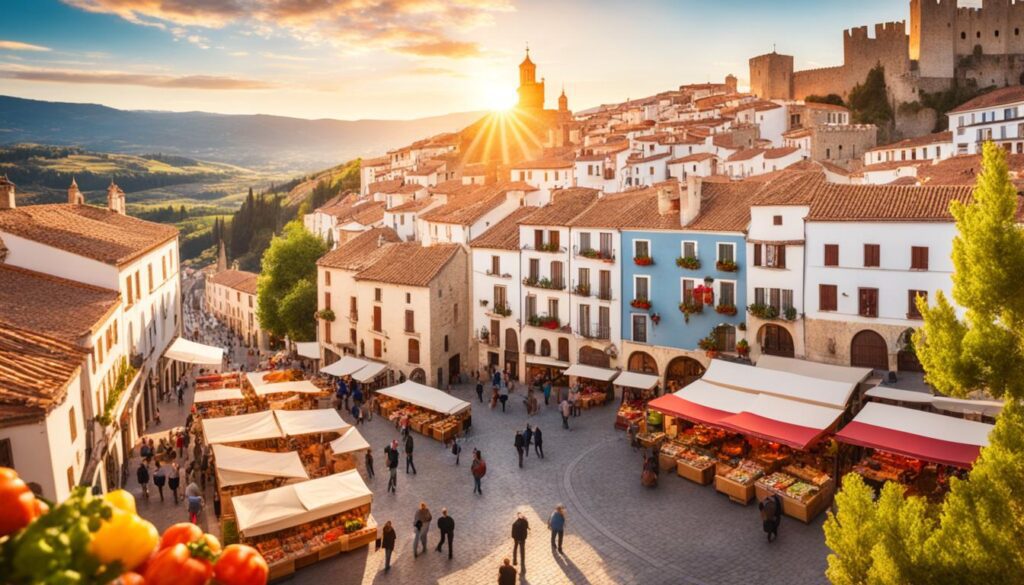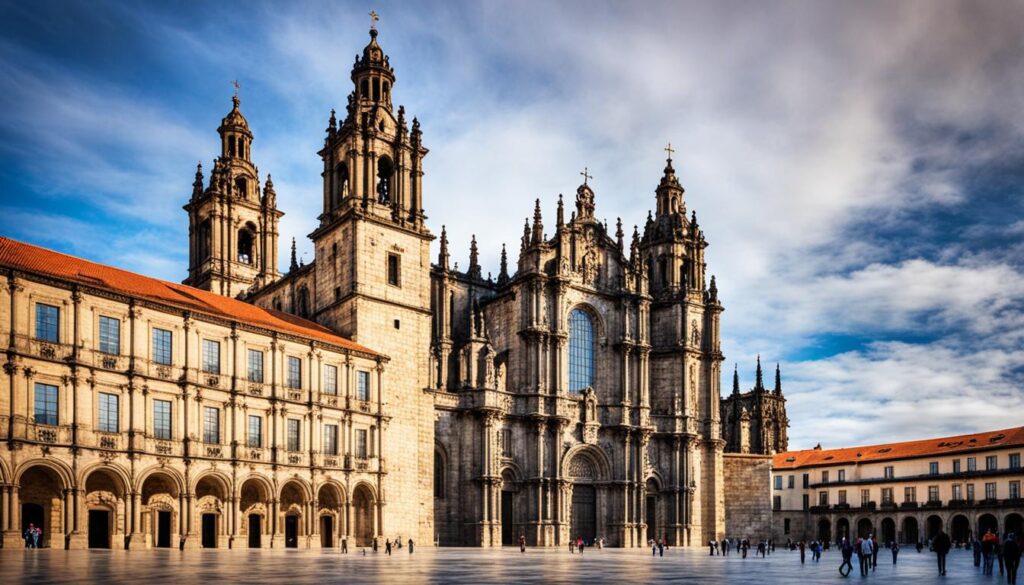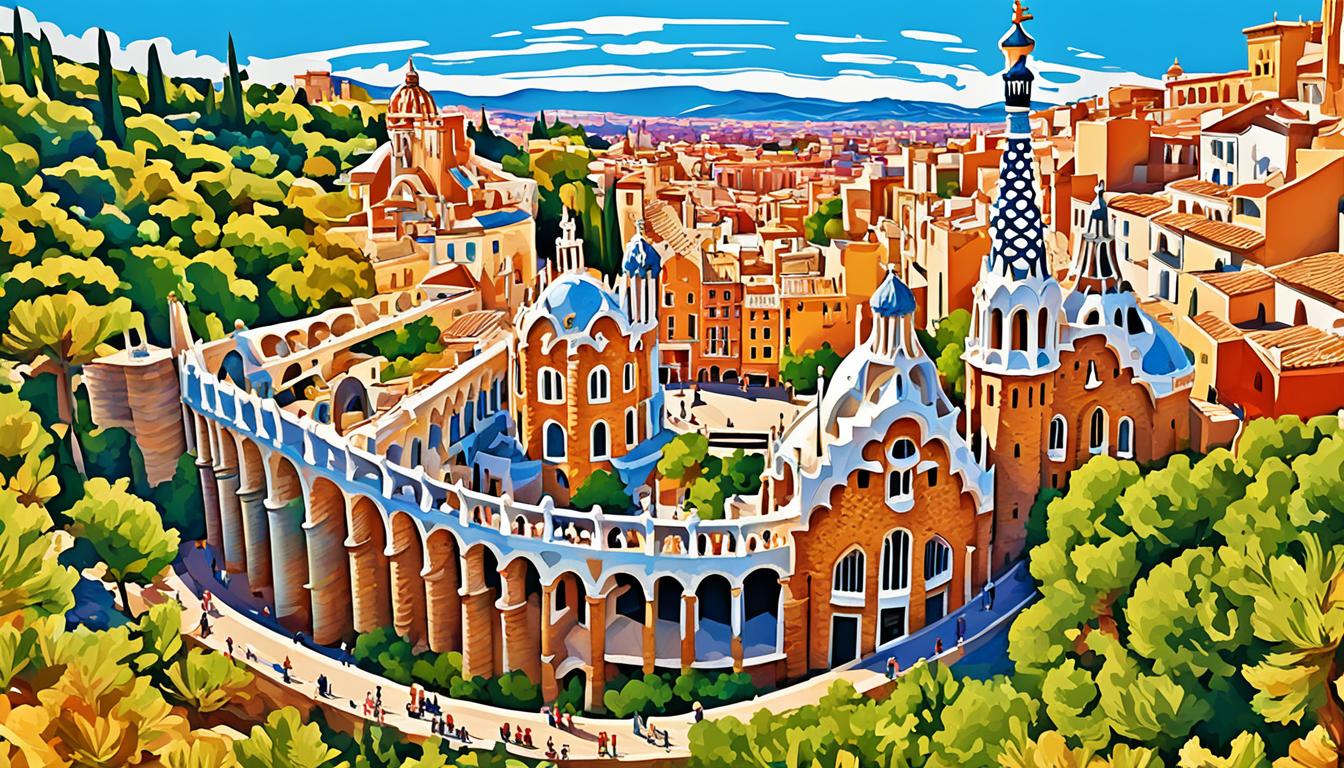Spain is a dream destination for travelers. It offers grandeur, sun-drenched beaches, and the vibrant culture of flamenco dancing. From the lively streets of Barcelona and Madrid to the stunning Great Mosque of Córdoba, Spain is full of life and history. This guide will show you the top attractions in Spain for an unforgettable trip.
Key Takeaways
- Spain is famous for its landmarks, architecture, and natural beauty.
- Must-see spots include the Alhambra in Granada and the Sagrada Familia in Barcelona.
- The Prado Museum in Madrid and the Guggenheim Museum in Bilbao are top art spots.
- Historic towns like Córdoba, Seville, and Santiago de Compostela offer a peek into Spain’s past.
- Coastal cities and natural landscapes like Costa del Sol and Ordesa y Monte Perdido National Park offer diverse experiences.
Alhambra and Generalife Gardens, Granada
The Moorish Architectural Marvel
The Alhambra and Generalife Gardens in Granada are a top spot for travelers. They offer a peek into alhambra palace granada and the beauty of moorish architecture spain. The complex boasts buildings, towers, walls, gardens, and a mosque. But it’s the stone carvings, filigrees, tile ceilings, arches, and courtyards that really stand out.
Started in the 13th century by the Moors, the Alhambra is a true wonder. The alhambra gardens and the landscape around them create a peaceful spot in the city. Visitors should plan to spend at least half a day here, checking out the Alcazaba fortress and the Palacio de Carlos V.
“The Alhambra is a vast, full-featured royal estate built over many centuries by various rulers. It is unmatched in its sheer beauty and marvelous in its ornamentation.”
Granada has more to offer beyond the Alhambra. You can explore the Albaicín, a medieval Moorish quarter, and the Sacromonte quarter for flamenco shows in gypsy caves. With its history, architecture, and gardens, Granada is a true treasure of moorish architecture spain.
Sagrada Familia and Gaudí Sites, Barcelona
Barcelona’s architecture is shaped by Antoni Gaudí’s amazing works. The Sagrada Familia stands out as a giant basilica started in 1882. It might take 30 to 80 years more to finish, depending on funds. This unfinished wonder draws about 3 million visitors every year.
Gaudí also left us Casa Milà, known as La Pedrera, with its organic design. It costs €30 to enter and is mostly wheelchair friendly. Casa Batlló, with its unique balconies, and Parc Güell, filled with fantasy creatures, are also must-sees.
For soccer fans, the FC Barcelona Museum at Camp Nou Stadium is a key spot. It’s open from 9:30 am to 7:00 pm in peak season. But, some parts of the Camp Nou Experience Tour are closed for renovation, expected to end by 2026.
| Attraction | Entrance Fee | Annual Visitors |
|---|---|---|
| Sagrada Familia | €26 – €36 | 3 million |
| Casa Milà (La Pedrera) | €30 | N/A |
| Parc Güell | €10 | N/A |
| FC Barcelona Museum | N/A | N/A |
Gaudí’s style, blending Art Nouveau with the absurd, draws all ages. His buildings, like the Sagrada Familia and Parc Güell, are a joy to behold. They’re the top sights in Barcelona.
The Great Mosque of Córdoba (La Mezquita)
In the heart of Córdoba, the Great Mosque of Córdoba, or La Mezquita, stands as a stunning example of Moorish architecture in Spain. This architectural wonder is among the largest mosques globally. It beautifully combines Islamic and Christian styles, making it a key spot for visitors in Córdoba.
The mosque started in 785 under Abd ar-Rahman I and finished in 786-787. Over time, it grew and changed, showing off the famous Moorish architecture of Spain. The original minaret, built by Abd ar-Rahman III in 951-952, was later updated by Christians in the 16th and 17th centuries.
The mosque’s vast interior is almost 14,400 square meters, making it one of the biggest mosques in the world. Its rows of columns and Moorish arches form a beautiful, symmetrical pattern. This design brings a sense of grandeur and peace.
Even after becoming a Catholic cathedral in 1236, the Great Mosque of Córdoba kept much of its Islamic feel. The Mihrab and Maksura areas at the south end are especially beautiful.
Visitors can also climb the 54-meter-high bell tower for amazing city views. The sound-and-light show at the mosque in the evenings is a highlight. It takes you back to the mosque’s rich past.
Whether you’re looking at the columns, the Mihrab details, or the city from the bell tower, the Great Mosque of Córdoba is a top spot in Spain. It shows off the amazing Moorish architecture that has drawn people for centuries.
Seville Cathedral and Alcázar
In the heart of Seville, Spain, two landmarks show the city’s rich history – the Seville Cathedral and the Alcázar of Seville. These places are known for their beauty and history. They are a must-see for anyone visiting Seville.
Seville Cathedral: A Towering Gothic Masterpiece
The Seville Cathedral is the biggest Gothic cathedral in the world. It stands tall in the city. Visitors can see its beauty from outside and inside, where they can walk among huge columns.
Inside, the main altar is covered in gold and has statues. The tomb of Christopher Columbus is also a sight to see.
Next to the cathedral is La Giralda, a beautiful Almohad architecture piece. It used to be the minaret of the Great Mosque. Going to the top gives amazing views of Seville.
Alcázar of Seville: A Moorish-Christian Architectural Fusion
The Alcázar of Seville is near the cathedral. It started as a Moorish palace in 712 AD and was changed after the Christian takeover. This palace is a mix of Moorish and Mudéjar styles.
It has beautiful rooms and gardens with orange and lemon trees. The gardens were even in the TV show “Game of Thrones.” This makes the Alcázar even more popular with visitors.
Visitors love the Seville Cathedral for its Gothic beauty and the Alcázar for its Moorish style. These places are top spots in Seville. They show the city’s history and culture.
Museo del Prado and Paseo del Arte, Madrid
Madrid’s Museo del Prado is a top art museum in the world. It has the biggest collection of Spanish and European art. You can see works by famous artists like Goya, Raphael, Rubens, and Velázquez.
The Prado Museum turned 200 years old in 2019. It has over 8,600 paintings and more than 700 sculptures. This makes it a key place for art lovers.
Madrid has more art spots like the Reina Sofía National Art Museum, the Thyssen-Bornemisza National Museum, and the CaixaForum. They’re all along the Paseo del Arte or Boulevard of the Arts. This area is filled with priceless art.
The Prado Museum has guided tours for 1, 2, and 3 hours. This helps visitors see the museum’s huge collection quickly. In 2021, the museum opened a new permanent display with 265 items.
| Museo del Prado Key Facts | Paseo del Arte Museums |
|---|---|
| – Opened on November 10, 1819 – 8,600 paintings and over 700 sculptures in the collection – Hosts temporary exhibitions and restoration workshops |
– Reina Sofía National Art Museum – Thyssen-Bornemisza National Museum – CaixaForum – Art Walk Pass available for all three museums |
The Prado Museum is a top spot in Madrid. It shows how Spanish art has changed over time. The museum has many things to see, like temporary shows and places to eat.
top tourist attractions in spain
Spain is a place that calls to travelers with its deep history, varied culture, and stunning nature. You’ll find the grand Alhambra Palace in Granada and the amazing works of Gaudí in Barcelona. These landmarks show off Spain’s incredible heritage. You’ll be amazed by the Great Mosque of Córdoba and the huge Seville Cathedral.
But there’s more to see than just famous spots. Spain has lively cities, beautiful beaches, and natural sights for a full travel experience. In Madrid, you can visit top art museums like the Prado. Or see the royal beauty of the San Lorenzo de El Escorial.
| Top Tourist Attractions in Spain | Entrance Fees |
|---|---|
| Sagrada Familia, Barcelona | €11-€26 |
| Alhambra Palace, Granada | €7-€17 |
| Royal Palace, Madrid | €10-€12 |
| Seville Cathedral | €9-€12 |
| Santiago de Compostela Cathedral | €6-€15 |
If you love Spain’s famous landmarks or want to find hidden spots, Spain has something for everyone. It promises an unforgettable trip full of culture and beauty.

“Spain is a magical country that captivates visitors with its vibrant culture, stunning architecture, and breathtaking natural landscapes.”
San Lorenzo de El Escorial
The Royal Monastery and Palace
Just 50 kilometers northwest of Madrid is the town of San Lorenzo de El Escorial. It’s famous for its Royal Monastery complex. King Philip II built it in the 16th century as a royal retreat and a tribute to his rule. You can see the monastery, church, royal palace, mausoleum, library, and museum. They all make up a UNESCO World Heritage site.
The Royal Monastery of San Lorenzo de El Escorial is huge, with over 4,000 rooms. It’s where Spanish monarchs from the Habsburg and Bourbon dynasties rest. The mix of Renaissance and Classical styles shows Spain’s rich history. You can learn more by visiting the Museum of Architecture, Library, and Painting Museum. They have old manuscripts, documents, and artworks.
“El Escorial was known as the ‘8th Wonder of the World’ during the late 16th century.”
San Lorenzo de El Escorial is more than just the monastery. The town has a lot to offer in culture and food. You can walk through the historic district, try traditional food, and go on day trips to places like Ávila, Segovia, Toledo, and Madrid. Its history and beautiful location in the Guadarrama mountains make it a top spot near Madrid and Spain.
| Attraction | Highlights |
|---|---|
| Royal Monastery of San Lorenzo de El Escorial |
|
| Town of San Lorenzo de El Escorial |
|
Guggenheim Museum, Bilbao
The Guggenheim Museum Bilbao is a modern art museum that draws visitors from all over. It was designed by famous architect Frank Gehry. The museum’s building is covered in titanium and is a masterpiece itself, attracting visitors with its bold design.
Inside, the museum shows off contemporary and avant-garde art. You’ll see everything from site-specific installations to paintings and sculptures. The exhibits change often, thanks to temporary shows.
The Guggenheim Museum has changed Bilbao for the better. It helped turn the city from industrial to a cultural and tourist hotspot. Now, Bilbao is known for its art, architecture, and tourism, making it a top spot in Spain.
| Attraction | Duration |
|---|---|
| Visit to the Guggenheim Museum Bilbao | 5 hours |
| Family Tour | 90 minutes |
| Express Tour | 45 minutes |
| Architecture Tour | 90 minutes |
| Exploring the Works from the Guggenheim Museum Bilbao Collection | 90 minutes |
| Visiting the Temporary Exhibitions | 40-60 minutes |
If you love art or just want a unique experience, the Guggenheim Museum Bilbao is a must-see. It’s perfect for anyone visiting Bilbao and the Spain art scene.
Santiago de Compostela Cathedral
In northwest Spain, the Santiago de Compostela Cathedral is a symbol of faith and pilgrimage. It’s the end point of the famous Camino de Santiago. For centuries, it has drawn people with its beauty and history.
The cathedral started in 1075 and has grown over time. It combines Gothic, Baroque, Romanesque, and Neoclassical styles. The Portico de la Gloria is a highlight, filled with sculptures by Master Mateo in 1188. It tells the story of the Apocalypse and features Saint James the Apostle.
Inside, the cathedral is just as stunning. It has tombs of kings and queens from the 12th to 15th centuries. There’s also the Cathedral Museum with works by Rubens and Goya, and the Cathedral Treasury.
The cathedral is more than just a building. In the Middle Ages, it was as important as Jerusalem and Rome for pilgrims. The Camino de Santiago route has been a spiritual path since the 9th century. The scallop shell, the Camino’s symbol, guides and inspires those on their journey.
Today, the cathedral is a top attraction in Spain. It draws pilgrims and travelers from all over. Whether you’re on a spiritual quest or just exploring, it offers a memorable experience.
| Key Facts | Details |
|---|---|
| Construction Timeline | The cathedral’s construction began in 1075 and evolved over the centuries, incorporating various architectural styles. |
| Architectural Highlights | The Portico de la Gloria features 200 sculptures by Master Mateo, depicting figures from the Apocalypse story and Saint James the Apostle. |
| Historical Significance | During the Middle Ages, Santiago de Compostela was considered a premier pilgrimage destination, equal to Jerusalem and Rome. |
| Pilgrim’s Symbol | The scallop shell, the symbol of the Camino de Santiago, is used to mark historic sites along the Way of St. James. |
| Annual Visitors | The Santiago de Compostela Cathedral attracts over 300,000 pilgrims and thousands of tourists each year. |

“During the Middle Ages, Santiago de Compostela was considered equal to Jerusalem and Rome as a pilgrimage destination.”
Vibrant Cities and Coastal Gems
Spain is known for more than just its landmarks and history. It has vibrant cities and beautiful coasts that attract travelers. Vibrant cities like Barcelona and Madrid offer a peek into Spain’s diverse culture. These cities are full of life, with Gaudí’s architecture and lively plazas.
The coast is home to places like the Balearic Islands, Costa Brava, and Costa del Sol. These spots offer stunning views, charming towns, and fun activities. Whether you’re into famous landmarks or hidden spots, Spain has something for everyone.
| City | Population | Highlights |
|---|---|---|
| Madrid | Just shy of 1 million | Third-largest city in Spain, home to Museo del Prado, Reina Sofía, and Thyssen-Bornemisza art museums |
| Granada | Under 500,000 | Located at the foot of the Sierra Nevada mountain range, known for the majestic Alhambra Moorish fortress |
| Palma de Mallorca | Over 500,000 | Offers some of the most beautiful panoramas among Spanish cities |
| San Sebastián | Just over 430,000 | Part of the Basque region, known for its Michelin-starred restaurants |
| Malaga | N/A | Previously known for fishing, now a popular tourist destination along the Costa del Sol |
| Valencia | Just under 1 million | The third-largest city in Spain, known for its rich history and being the birthplace of paella |
Whether you’re into the bustling cities, beautiful coasts, or must-see spots, Spain has it all. Its cities and coasts offer a mix of travel highlights that will leave you inspired.
“Spain’s cities and coastlines are a feast for the senses, from the architectural wonders of Barcelona to the sun-drenched beaches of the Costa del Sol.”
Historic Towns and Natural Wonders
Spain is more than just famous tourist spots. It’s full of historic towns and natural wonders waiting to be explored. From the white villages of Andalusia to the dramatic cliffs of Costa Brava, there’s a lot to see. These places show off Spain’s rich culture and stunning nature.
Discovering Spain’s Hidden Treasures
Places like Segovia’s old town, Toledo’s ancient city, and the Teide volcano in the Canary Islands let you see a different side of Spain. These spots take you back in time and show you the beauty of today, inviting you to explore less-known parts of this amazing country.
Spain is a leader in protecting nature, with 300 nature reserves, 16 national parks, and more. It has 152 natural parks and 28 recognized by the European Charter for Sustainable Tourism. With 15 geoparks and 53 biosphere reserves, it’s clear Spain cares about its nature.
| Region | Highlights |
|---|---|
| Castilla-La Mancha | Lagunas de Ruidera Natural Park, part of the La Mancha Húmeda biosphere reserve |
| Castile and Leon | 10 biosphere reserves, the highest number in Spain |
| Catalonia | Aigüestortes i Estany de Sant Maurici National Park, with the Sant Quirc de Durro natural viewing point |
| Extremadura | Monfragüe National Park, known for wildlife observation and the Salto del Gitano viewpoint |
| La Rioja | Sierra de Cebollera Natural Park, home to the Puente Ra waterfalls |
| Madrid | Sierra de Guadarrama National Park, featuring the Siete Picos route and the Montejo Beech Forest |
From the Foz de Lumbier gorge in Navarre to the Gujuli waterfall in the Basque Country, Spain’s nature is diverse. Places like Murcia’s Salto del Usero and Lanzarote’s Timanfaya National Park offer unique landscapes and activities. These spots let travelers dive into Spain’s hidden gems.
“By venturing off the beaten path, travelers can uncover Spain’s hidden treasures and gain a deeper appreciation for the country’s multifaceted charm.”
Conclusion
Spain is a treasure trove of attractions that draw visitors from all over. You can see the Alhambra and Sagrada Familia’s stunning architecture. Or visit Madrid’s cultural spots and the historic cathedrals of Seville and Córdoba. These landmarks highlight Spain’s rich heritage and lasting charm.
But there’s more than just famous sites. Spain’s cities are lively, its coasts are beautiful, and its nature is breathtaking. There’s always something new to discover.
If you want to dive into history, admire architecture, or just enjoy the scenery, Spain won’t disappoint. This guide helps you plan your trip to see the best of Spain. It covers everything from travel guides to tourism tips, so you’re ready for an amazing journey.
Spain calls to those who love culture, architecture, and nature. This guide is perfect for first-timers or seasoned travelers. It gives you all you need to enjoy your trip to Spain. Experience its history, modernity, and beauty for yourself.

